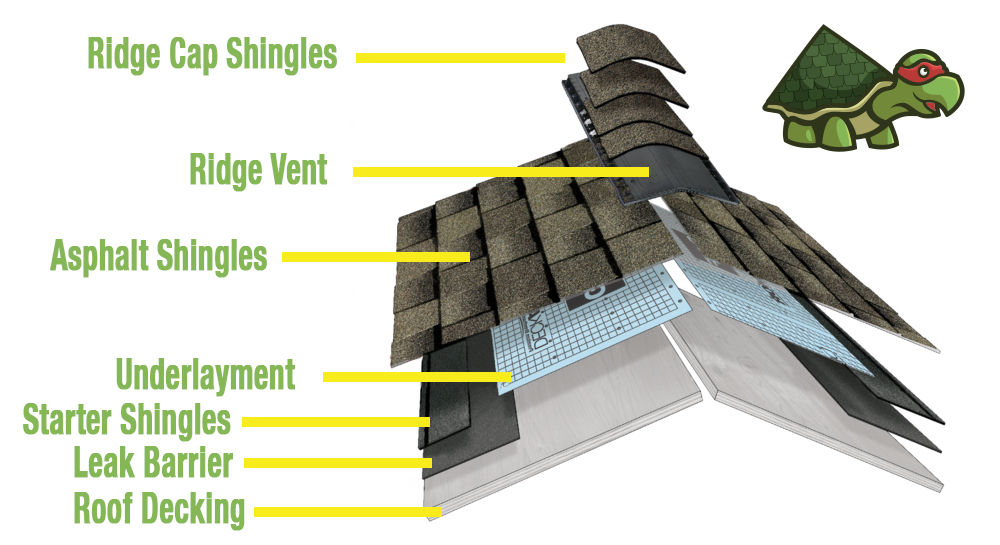As a homeowner in Bastrop, Texas, it’s essential to understand the terminology associated with your roof. Having a solid grasp of roofing terms allows you to communicate effectively with contractors, make informed decisions, and ensure the proper care and maintenance of your roof. In this comprehensive glossary, we’ll explore common roofing terms specifically tailored for homeowners in Bastrop.
Roofing Term Glossary

Roof Components and Structures
Roof Deck: The structural base of the roof that provides support for the roofing materials.
Underlayment: A waterproof layer installed on top of the roof decking and beneath the roofing materials to provide an extra layer of protection against water penetration.
Flashing: Metal strips used to seal and protect vulnerable areas of the roof, such as joints, valleys, and chimney intersections.
Ridge Vent: A ventilation system installed along the ridge of the roof to promote airflow and reduce heat buildup in the attic.
Starter Shingles: Designed to reduce the risk of shingle blow-off and to lock the shingles in place.
Leak Barrier: A device that is reinforced with fiberglass to protect from leaks. They are placed in several places including valleys, rakes, along eaves and around chimneys.
Eaves: The lower edges of the roof that overhang the walls of the house.
Soffit: The underside of the eaves, typically ventilated to allow for airflow.
Fascia: The board that runs along the lower edge of the roof, supporting the eaves and connecting them to the walls.
Valley: The area where two roof planes intersect, typically forming a “V” shape.
Gutter: A trough installed along the roof’s edge to collect and redirect rainwater away from the house.

Roofing Materials
3-Tab Shingle: A type of asphalt shingle that is composed of a single layer with three tabs, giving it a traditional flat and uniform appearance. It is cost-effective and widely used in residential roofing.
Architectural Shingle: Also known as laminated or dimensional shingles, architectural shingles are asphalt shingles that are thicker and have a multi-dimensional appearance. They are designed to mimic the look of more expensive roofing materials such as wood shakes or slate.
Asphalt Shingles: The most common roofing material, made of asphalt-coated fiberglass or organic material.
Cool Roof Shingle: A shingle that is specially designed to reflect more sunlight and absorb less heat, helping to keep the building cooler and reduce energy consumption. Cool roof shingles are typically made with reflective materials or coatings.
Designer Shingle: High-end shingles that offer unique and visually appealing designs, textures, and colors. These shingles are often made with premium materials and can resemble slate, cedar shakes, or other high-end roofing options.
Metal Roofing: Roofing panels or shingles made of metal, known for their durability and longevity.
Slate: A natural stone material commonly used for upscale roofing, offering a distinctive appearance and exceptional durability.
Synthetic Shingles: A durable shingle usually made of a polymer.
Tile Roofing: Roofing made of clay or concrete tiles, providing a unique aesthetic and durability.
Wood Shake: Shingles made from split logs, offering a rustic and natural look.
Roofing Techniques and Processes
Roof Installation: The process of installing a new roof, including preparing the roof deck, underlayment, and roofing materials.
Roof Repair: Fixing damaged or deteriorated areas of the roof to ensure its integrity.
Roof Replacement: Completely removing the existing roof and installing a new one.
Roof Maintenance: Regular inspections, cleaning, and minor repairs to extend the lifespan and performance of the roof.
Ridge Cap Shingles: Specialized shingles installed on the ridge line to provide additional protection and a finished look.
Roof Deck Protection: Protective layers installed on the roof deck before the main roofing material to enhance waterproofing and durability. Also known as underlayment.
Roofing Felt: A type of underlayment consisting of a bituminous material, offering an additional layer of protection against moisture.
Roofing Terminology
Pitch/Slope: The steepness or angle of the roof.
Square: A unit of measurement used in roofing, representing 100 square feet.
Rake: The sloped edge of a gable roof that runs from the eaves to the ridge.
Drip Edge: A metal flashing installed along the roof edges to direct water away from the fascia and prevent water damage.
Ice Dam: A ridge of ice that forms at the edge of the roof, preventing proper drainage and potentially causing water leakage.
Ventilation: The process of allowing air to circulate in the attic space to prevent moisture buildup and regulate temperature.
Uplift Resistance: The ability of the roof to resist wind forces that could lift or dislodge it.
Dormer: A structural element projecting from a sloped roof, typically containing a window.
Soffit Vent: Vents installed in the soffit to allow fresh air into the attic.
How Understanding Roofing Terms Benefits Homeowners
Having a solid understanding of roofing terminology offers several advantages for homeowners in Bastrop, Texas. It enables effective communication with roofing contractors, ensuring clear project discussions and accurate cost estimates. By familiarizing yourself with roofing terms, you can actively participate in decision-making processes, selecting the right materials, and understanding the scope of repairs or replacements needed. Additionally, knowing roofing terminology helps you appreciate the importance of regular maintenance and identify potential issues before they escalate, safeguarding the integrity and longevity of your roof.
If you’re looking for a new roof, repairs or a maintenance plan, call Roofing Turtle at 1-833-688-7853 or enter some basic info on our website and we’ll get back to you!

